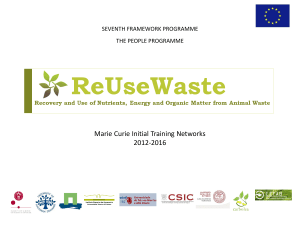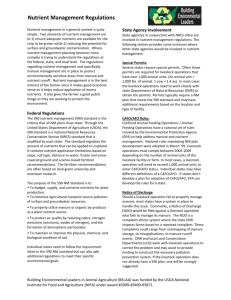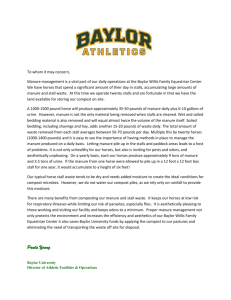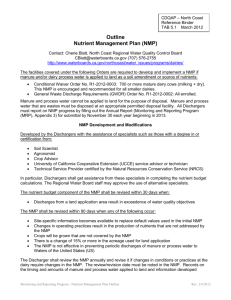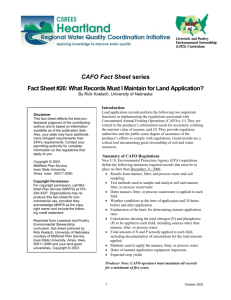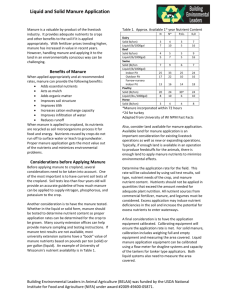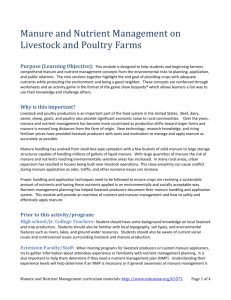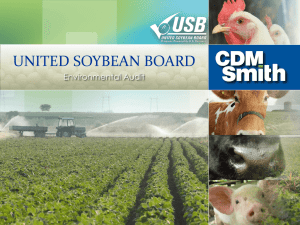Nutrient Management Plan Checklist for CAFOs
advertisement
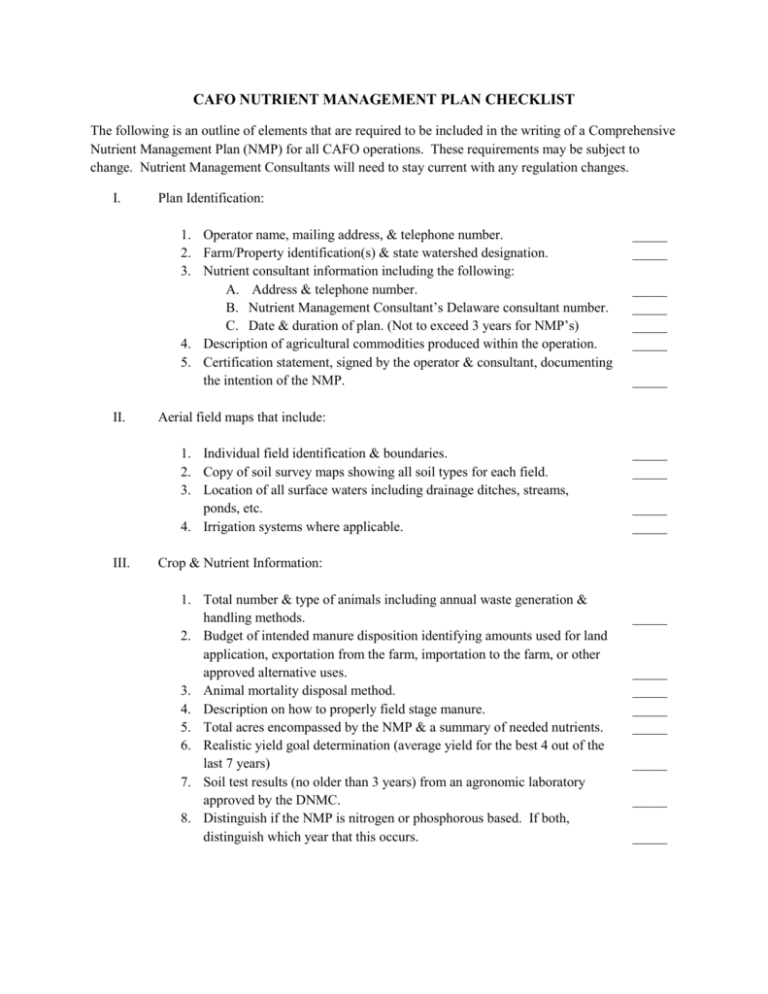
CAFO NUTRIENT MANAGEMENT PLAN CHECKLIST The following is an outline of elements that are required to be included in the writing of a Comprehensive Nutrient Management Plan (NMP) for all CAFO operations. These requirements may be subject to change. Nutrient Management Consultants will need to stay current with any regulation changes. I. Plan Identification: 1. Operator name, mailing address, & telephone number. 2. Farm/Property identification(s) & state watershed designation. 3. Nutrient consultant information including the following: A. Address & telephone number. B. Nutrient Management Consultant’s Delaware consultant number. C. Date & duration of plan. (Not to exceed 3 years for NMP’s) 4. Description of agricultural commodities produced within the operation. 5. Certification statement, signed by the operator & consultant, documenting the intention of the NMP. II. _____ _____ _____ _____ _____ Aerial field maps that include: 1. Individual field identification & boundaries. 2. Copy of soil survey maps showing all soil types for each field. 3. Location of all surface waters including drainage ditches, streams, ponds, etc. 4. Irrigation systems where applicable. III. _____ _____ _____ _____ _____ _____ Crop & Nutrient Information: 1. Total number & type of animals including annual waste generation & handling methods. 2. Budget of intended manure disposition identifying amounts used for land application, exportation from the farm, importation to the farm, or other approved alternative uses. 3. Animal mortality disposal method. 4. Description on how to properly field stage manure. 5. Total acres encompassed by the NMP & a summary of needed nutrients. 6. Realistic yield goal determination (average yield for the best 4 out of the last 7 years) 7. Soil test results (no older than 3 years) from an agronomic laboratory approved by the DNMC. 8. Distinguish if the NMP is nitrogen or phosphorous based. If both, distinguish which year that this occurs. _____ _____ _____ _____ _____ _____ _____ _____ CAFO NUTRIENT MANAGEMENT PLAN CHECKLIST (Cont’d) Crop & Nutrient Information (cont’d): III. IV. 9. Current & planned crop rotation. _____ 10. Methods for land application of manure. 11. Manure application setbacks from ditches, streams, or other designated waters of the state that include the following options: A. 100’ application setback from the top of ditch bank. B. 35’ permanent vegetated buffer strip measured from ditch bank. C. 10’ application setback with permanent vegetated buffer strip. Measured from ditch bank if soil phosphorous (P) levels are UD FIV 150 or greater on soil tests. Winter cover crop planted in field. D. 10’ application setback with NO permanent vegetated buffer strip. Measured from ditch bank if soil phosphorous (P) levels are UD FIV 149 or less on soil tests. Winter cover crop planted in field. 12. Determination of nitrogen application rate based on expected crop yields. 13. Phosphorous application is limited to 3-year crop removal rates with a Fertility Index Value (FIV) of 150 or greater. A University of Delaware Phosphorous Site Index (PSI) can be performed and P may be applied as recommended by the PSI. 14. Estimation of residual nitrogen (organic nutrients, fertilizer, or legume crops from previous year) 15. Nutrient source(s), recommended application rates, & approximate timing of nutrient applications. 16. Manure analysis – must be performed yearly. Copies must be maintained by the operator and a copy sent to the DE. Department of Agriculture. _____ _____ _____ _____ _____ _____ _____ _____ Best Management Practices: 1. Best Management Practices (BMP’s) recommendations to enhance agronomic and environmental practice (ex. Pre-side dress Soil Nitrate Test – PSNT, cover crops, vegetated buffers, litter additives, manure incorporation, timing/method, Heavy Use Area Pads – HUAPs on poultry houses & manure sheds, poultry windbreaks, etc.) V. _____ _____ Implementation Requirements & Records: 1. Operator maintains certain implementation records for 6 years. 2. DDA notified of plan changes due to catastrophic event or increase in animal units or cropland acres of 25% or greater. 3. Manure staging protocols: A. At least 100’ from any body of water or drainage ditch. B. At least 100’ from any public road. C. At least 200’ from any residence that is not located on the person’s property. D. At least 200’ from a private well. E. At least 300’ from a public well. F. At least 6’ high & in a conical shape. 4. If operator exports manure, a log must be kept that includes the date, approximate tonnage, & the receiver of the manure. _____ _____ _____ _____ _____ _____ _____ _____ _____ CAFO NUTRIENT MANAGEMENT PLAN CHECKLIST (Cont’d) VI. Other elements to be addressed in the CAFO CNMP: 1. Clean water management – plan to address management of clean water in the production area from contacting manure. 2. Preventing animals from contacting waters of the state – plan to address how operation prevents animals from having direct contact with waters of the state. 3. Proper chemical handling – plan to address how chemicals in the production area will not come into contact with manure & wastewater. VII. _____ _____ _____ Reporting Requirements: 1. Operation must submit a Nutrient Management Annual Report by March 1st of every year to the DDA. (Operator to retain a copy for his/her records). 2. When a NMP has expired and a new plan has been developed, a copy of the new plan must be sent to the DDA. 3. Upon a 25% increase in animal units or crop acres, the NMP must be updated immediately. 4. A copy of 1 manure analysis must be sent to the DDA. (Operator to maintain a copy for his/her records) VIII. 9 Elements that must be addressed in any CAFO Animal Waste Management Plan (AWMP) or CAFO Nutrient Management Plan (NMP): 1. 2. 3. 4. 5. 6. 7. 8. 9. Adequate storage capacity for manure, litter, & process wastewater. Proper management of dead animals. Clean water management. Preventing animals from contacting waters of the state. Proper chemical handling. Methods for land application of manure. Implementing conservation practices to control nutrient loss. Testing manure & soil. Proper record keeping. _____ _____ _____ _____ _____ _____ _____ _____ _____


